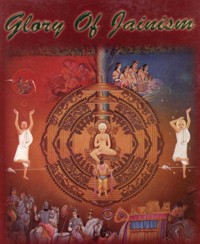Jaina Beliefs
Nature of reality (sat): Jainism maintains that reality has infinite characters or aspects and its nature is constituted of substance and modes (forms). Reality is neither substance alone nor alone modes. Substance persists through changing modes. Modes come into existence and perish. So Jaina thinkers define reality as characterised by the trio of origination, destruction and persistence. Even soul is not an exception to it.
Non-onesidedness (anekantavada):
Corresponding to the infinite characters or aspects of reality there are infinite views. Different views grasp and present different aspects of reality as they are governed by different conditions of purpose, intention, relevance, etc. Each view, though does not contain the whole truth, does contain the partial truth. So no view should be rejected. Every view should be respected. Man should not indulge in dogmatic absolute assertion, disregarding other views and mistaking the partial truth for the whole truth. He should recognise a spark of truth present in different views and attempt a synthesis of them all in order to arrive at the comprehensive truth. This theory of standpoints and their synthesis fosters intellectual tolerance and nourishes friendliness.
Six substances (sad-dravya):
Jainism recognises six substances, viz. soul (jiva), matter (pudgala), medium of motion (dharma), medium of rest (adharma), space (akasha) and time (kala). Soul is the only sentient substance. The rest are insentient (ajiva). Time, medium of motion and medium of rest act as the assisting causes of change, motion and rest respectively. Space acts as a universal container in which all other substances are contained. Space is infinite. All other five substances are eternally confined to a particular portion of the infinite space. This portion is called universe (loka), while the remaining empty pure infinite space is called the region-beyond-the-universe (aloka).
Soul (jiva):
There are infinite souls, each living being having a separate soul. The nature of soul is consciousness or sentiency. It is fundamentally different from matter (physical body). It expands and contracts according to the size of body it assumes in different births. It knows things, performs activities, enjoys pleasures, suffers pains, and illumines itself and other objects.
Law of moral causation (karma):
All souls are inherently or potentially equal. The inequalities we notice in the world is due the fine karmic matter that veils the natural qualities of souls from beginningless time. The karmic matter is attracted towards and bound to the soul on account of its mental, vocal and bodily activities and dissociated from it as soon as it bears its fruit. When acts are performed with intense passions, the karmic matter obscures the quality for long and gives bitter fruits. So ultimately passions are the root-cause of misery and bondage. When passions are totally exterminated, all the bound karmic matter gets totally dissociated from the soul and ultimately the soul attains its pure state or liberation. The theory of moral causation necessarily implies rebirth. Every act must necessarily be followed by its consequence. If the consequences of our acts have not been experienced in the present life, they necessarily demand a future life (rebirth) for their fruition.
Liberation (moksha):
Liberation means the attainment of pure state of infinite knowledge and infinite bliss. This state is attained on the complete dissociation of the soul from obscuring karmic matter. And this complete dissociation is achieved by stopping (samvara) through self-control the inflow of new karmic matter into soul as well as by complete premature voluntary elimination (nirjara) of the bound karmic matter through special austerities and pure meditation. As soon as the soul becomes absolutely free from the burden of karmic matter, it moves upward (because upward motion is natural to the soul) and reaches the summit of the universe where it rests for ever (because beyond the upper limit of the universe there exists no medium of motion to assist it to move upward further). Liberation is attained through human body only. There is no possibility of fall from the state of liberation. For Jainas the liberated perfected soul is God. They do not believe in one world-creator God.
To attain liberation, it is necessary to have the following three qualities known as three Jewels (ratna-traya):
- Spiritual inclination or faith in self-evident spiritual truths, viz. I (soul) exist, I am afflicted with miseries, there are causes of miseries, I can totally exterminate these causes, and as a result I can absolutely free myself from all misery. This is called samyag-darshana.
- Spiritually wholesome knowledge (samyag-jnana): All knowledge that is associated with and directed by spiritual inclination or faith is spirimally wholesome knowledge.
- Spiritually wholesome conduct (samyak-charitra): The conduct this inspired by the spiritually wholesome knowledge is necessarily spiritually wholesome conduct.
The three combined are the means of liberation.
 Dr. Kumarpal Desai
Dr. Kumarpal Desai
